Archives: Projects
Chicago's Tunnel and Reservoir Plan (TARP)
Thirty TBMs participate in Chicago’s Epic Tunnel and Reservoir Plan (TARP)
Project Description
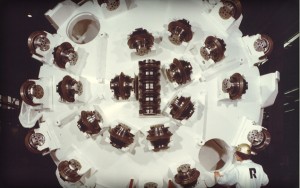 Spanning 20 years and using over 30 TBMs, Chicago’s massive Tunnel and Reservoir Plan (TARP) has been possibly the largest clean water project of the twentieth century. The TARP was created in 1975 to combat increased flooding and drainage problems that plagued Chicago and surrounding areas. After heavy rains, combined sewage overflows (CSOs) would seep into residential basements, nearby streams and rivers, as well as Lake Michigan – Chicago’s main source for drinking water. TARP was originally divided into two phases but now refers solely to Phase I.
Spanning 20 years and using over 30 TBMs, Chicago’s massive Tunnel and Reservoir Plan (TARP) has been possibly the largest clean water project of the twentieth century. The TARP was created in 1975 to combat increased flooding and drainage problems that plagued Chicago and surrounding areas. After heavy rains, combined sewage overflows (CSOs) would seep into residential basements, nearby streams and rivers, as well as Lake Michigan – Chicago’s main source for drinking water. TARP was originally divided into two phases but now refers solely to Phase I.
Phase I
Phase I was directed towards pollution control and consisted of tunnels, drop shafts, and dewatering stations to eliminate nearly 85 percent of CSO pollution. Four tunnel systems comprise the first phase: Mainstream, Des Plaines, Calumet and O’Hare, which have a combined length of 176.1 km (109.4 mi) and range in diameter from 2.4 m to 10.8 m (8.0 ft to 35.4 ft). Nearly all of the tunnels were excavated in the area’s dolomitic limestone, and required the use of TBMs up to 10.8 m in diameter—the largest TBMs that had ever been built at the time.
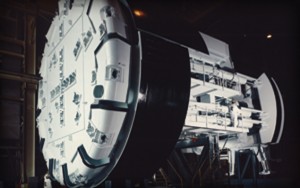 The Mainstream Tunnel System was composed of 65.2 km (40.5 mi) of tunnel, the Des Plaines System with 41.2 km (25.6 mi), the O’Hare System with 10.6 km (6.6 mi), and the Calumet System of 59.1 km (36.7 mi). A later tunnel for the Little Calumet Leg of the Calumet system was excavated using a Robbins TBM in 2002, setting multiple records in the process including 138 m (452 ft) bored in one day. Immediately upon completion, each tunnel system was put into service and the benefits were seen almost instantaneously. After more than 30 years and over 160 km (100 mi) of tunnels, the entire first phase of the TARP system became operational in 2005.
The Mainstream Tunnel System was composed of 65.2 km (40.5 mi) of tunnel, the Des Plaines System with 41.2 km (25.6 mi), the O’Hare System with 10.6 km (6.6 mi), and the Calumet System of 59.1 km (36.7 mi). A later tunnel for the Little Calumet Leg of the Calumet system was excavated using a Robbins TBM in 2002, setting multiple records in the process including 138 m (452 ft) bored in one day. Immediately upon completion, each tunnel system was put into service and the benefits were seen almost instantaneously. After more than 30 years and over 160 km (100 mi) of tunnels, the entire first phase of the TARP system became operational in 2005.
Phase II
Phase II, now called the Chicago Underflow Plan (CUP), consists of three main reservoirs: the Majewski Reservoir, Thornton Reservoir, and McCook Reservoir with a combined capacity of 69.05 billion liters (18.24 billion gallons). The reservoirs are a joint project of the Water Reclamation District and the U.S. Army Corps of Engineers, built to provide flood relief by storing the water collected and transferred from the TARP tunnels until it can be treated at local reclamation plants.
Excavation and Breakthrough
Construction on the Majewski CUP Reservoir was started in 1990 and finished in 1998, with a capacity of 1.29 billion liters (342 million gallons). The Thornton Reservoir was divided into two stages, including a transitional reservoir completed in 2003, and a permanent CUP reservoir completed in 2015. The permanent CUP reservoir has a capacity of 29.9 billion liters (7.9 billion gallons) and provides an estimated $40 million annually to 15 communities. Finally, the McCook Reservoir, also planned as a two-stage build, will provide storage of up to 38 billion liters (10 billion gallons). The first stage was completed in 2017, while the completion date of the second stage is scheduled for 2029. To date, the reservoirs have yielded hundreds of millions of dollars in flood damage reduction benefits.
The TARP program has won numerous awards and honors over the years from the local and federal EPA, as well as the American Society of Civil Engineers award in 1986 for the most outstanding civil engineering project. The tunnels and reservoirs have resulted in a dramatic improvement to water quality in Lake Michigan, and have eliminated CSO overflows. Fish and wildlife have returned in recent years to local rivers and to Lake Michigan, and the waterfront property is becoming more attractive to businesses and the general population alike.
Pahang Selangor Raw Water Tunnel
Trio of TBMs bore Malaysia’s Largest Infrastructure Project
Project Overview
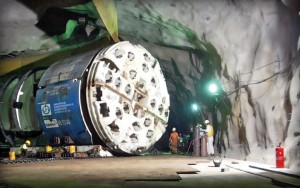 The Pahang Selangor Raw Water Tunnel, for the Malaysian Ministry of Energy, Green Technology, and Water, conveys raw water from the Semantan River in Pahang to the South Klang Valley area of Selangor state. The three tunnels, totaling 44.6 km (27.7 mi), address projected water shortages due to the area’s rapidly growing population. The tunnel transfers 27.6 cubic meters (7,300 gallons) of water per second to a new treatment plant. The drinking water supplies about 7.2 million people.
The Pahang Selangor Raw Water Tunnel, for the Malaysian Ministry of Energy, Green Technology, and Water, conveys raw water from the Semantan River in Pahang to the South Klang Valley area of Selangor state. The three tunnels, totaling 44.6 km (27.7 mi), address projected water shortages due to the area’s rapidly growing population. The tunnel transfers 27.6 cubic meters (7,300 gallons) of water per second to a new treatment plant. The drinking water supplies about 7.2 million people.
The SNUI JV, consisting of Shimizu Corporation, Nishimatsu Construction, UEM Builders Bhd, and IJM Construction, chose three Robbins 5.23 m (17.2 ft) diameter Main Beam TBMs to excavate the three sections of the tunnel. The total supply included back-up systems, continuous conveyors, cutters, spares, and field service personnel.
Ground Support and TBM Design
Tunneling took place in high cover conditions, up to 1,200 m (3,900 ft) below the Titiwangsa mountain range. Geology during the initial stages of advance consisted of hard, abrasive granitic rock up to 200 Mpa (29,000 psi) UCS. The tunnels were supported with ring beams, rock bolts, and shotcrete depending on the conditions. If unstable ground was encountered, invert thrust systems could be utilized to avoid gripping against the tunnel walls.
To successfully excavate the hard rock, each High Performance (HP) TBM was fitted with 19-inch (482 mm) back-loading disc cutters- making them the smallest diameter back-loading cutterheads ever provided. The cutters were carefully monitored for wear using remote monitoring systems. The wireless systems allowed the crew to plan cutter changes and keep track of wear by recording several variables on each cutter, including cutter rotation (which is computed to percentage wear), temperature, and vibration. Each 19-inch face and gage cutter was equipped with a sensor bolted inside the cutter housing, allowing raw data to be sent to a program display in the operator’s cabin.
Tunnel Excavation
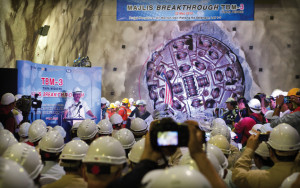 The first machine was launched on November 10, 2010, followed shortly after by the second on December 30, 2010. The third machine began boring in March 2011 and all three machines are currently boring as scheduled. All of the machines were assembled outside their particular adits, then “walked” down a 6-10% grade to an NATM-excavated starter tunnel. Two of the machines were launched with a shortened back-up configuration of 10 decks and a temporary transfer conveyor, while the third for logistical reasons utilized trucks for muck removal in the preliminary boring phase. Once the machines had advanced about 100 m (330 ft), the remaining back-up decks and permanent Robbins continuous conveyor were then installed, due to the adit configurations.
The first machine was launched on November 10, 2010, followed shortly after by the second on December 30, 2010. The third machine began boring in March 2011 and all three machines are currently boring as scheduled. All of the machines were assembled outside their particular adits, then “walked” down a 6-10% grade to an NATM-excavated starter tunnel. Two of the machines were launched with a shortened back-up configuration of 10 decks and a temporary transfer conveyor, while the third for logistical reasons utilized trucks for muck removal in the preliminary boring phase. Once the machines had advanced about 100 m (330 ft), the remaining back-up decks and permanent Robbins continuous conveyor were then installed, due to the adit configurations.
During the initial stages of advance, the machines achieved rates of up to 3.5 m (11.5 ft) per hour, leading the three machines to excavate over 1,400m (4,600 ft), 540 m (1,800 ft) and 330 m (1,100 ft), respectively by April 2011. As each TBM continued on its 11km (6.8 mi) run, the machinery had to overcome adversity including blocky rock, over-break, power outages and water inflows.
The machines maintained excellent advance rates throughout the project despite many challenges. Due to the hot springs the machines were boring under, water ingress at temperatures up to 56 degrees Celsius was recorded. Maximum rates of 49 m in one day, 198 m in one week, and 657 m in one month were nonetheless achieved.
Among other methods of ground support used during boring, the near-zero rebound fiber mortar (sprayed shotcrete) is the primary method being used during the Pahang Selangor Project. This marks the first time this method has been used outside of Japan. The success of this innovative implementation has been proven through reduced project downtime, dust reduction and good bonding.
Breakthrough
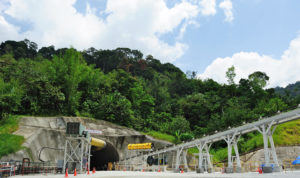 The first of three 5.23 m (17.2 ft) Main Beam Robbins TBMs broke through at the Pahang Selangor Raw Water Tunnel on March 22, 2013 to a large ceremony of cheering onlookers. The breakthrough was attended by dignitaries, contractors and honored guests, with everyone very enthusiastic about the machine’s success.
The first of three 5.23 m (17.2 ft) Main Beam Robbins TBMs broke through at the Pahang Selangor Raw Water Tunnel on March 22, 2013 to a large ceremony of cheering onlookers. The breakthrough was attended by dignitaries, contractors and honored guests, with everyone very enthusiastic about the machine’s success.
The two remaining 5.23 m (17.2 ft) machines met in the middle of the tunnel in mid-February 2014. It was a moment worthy of celebration; marking the completion of the longest tunnel in Southeast Asia.
Pinglu Tunnel
Veteran Double Shield completes one of the World’s Longest Single-Drive Tunnels
Project Overview
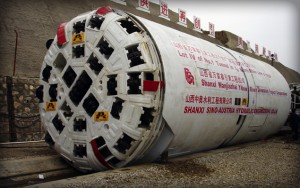 The Pinglu Tunnel, part of the Yellow River Water Diversion Project, was undertaken in 2006 by Joint Venture Sino-Austria Hydraulic Engineering Co. Ltd (SAHEC), led by Alpine Bau GmbH. At 24.5 km (15.8 mi), the Pinglu Tunnel marks one of the world’s longest single-drive TBM tunnels ever excavated. The entire scheme will transfer water from the Yellow River to dry regions of Shanxi Province, an area that receives just 400 mm (16 in) of rainfall per year on average.
The Pinglu Tunnel, part of the Yellow River Water Diversion Project, was undertaken in 2006 by Joint Venture Sino-Austria Hydraulic Engineering Co. Ltd (SAHEC), led by Alpine Bau GmbH. At 24.5 km (15.8 mi), the Pinglu Tunnel marks one of the world’s longest single-drive TBM tunnels ever excavated. The entire scheme will transfer water from the Yellow River to dry regions of Shanxi Province, an area that receives just 400 mm (16 in) of rainfall per year on average.
The completed Pinglu Tunnel will go into operation in October 2011, connecting the North Main Line of the Yellow River Project to transfer water to Pinglu, Shuozhou, and Datong areas. The South Main Line of the Yellow River Water Diversion Project was completed between 1999 and 2001, which encompassed over 100 km (62 mi) of tunnel excavated using five TBMs, four of which were Robbins Double Shield TBMs.
TBM Design
The Robbins Double Shield TBM excavating the Pinglu Tunnel was previously used on the record-breaking 12 km (7 mi) long segment of the Yellow River Diversion in 2000. During that project, the Double Shield set two world records in its size class of 4 to 5 m (13 to 16 ft): best month (1,855 m/6,085 ft) and monthly average (1,352 m/4,435 ft). Both records still stand.
Since the TBM was used on a prior tunnel for this project and designed for similar geology, only the back-up system was modified. Due to the length of the tunnel, the back-up frame was extended from one stroke to two strokes. This key change allowed the machine to maintain good advance rates despite 70 minute transit times for muck trains from the machine to the tunnel entrance.
Tunnel Excavation
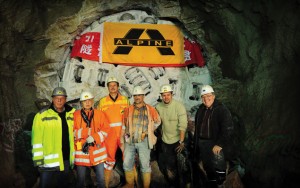 The machine began boring at the remote jobsite on September 30, 2006. Tunneling was a challenging process, as the geology consisted of 12 m (40 ft) thick coal seams and abrasive sandstone that required intensive monitoring of tunnel air for particulates. Up to 70% quartzite content made the rock very abrasive. This combination of 70% quartzite and 6% corundum made the rock seven times more abrasive than quartzite—equal to the material that grinding wheels are made of. This required rigorous maintenance of the cutterhead with a daily 4-hour shift, and replacement of the bucket lips.
The machine began boring at the remote jobsite on September 30, 2006. Tunneling was a challenging process, as the geology consisted of 12 m (40 ft) thick coal seams and abrasive sandstone that required intensive monitoring of tunnel air for particulates. Up to 70% quartzite content made the rock very abrasive. This combination of 70% quartzite and 6% corundum made the rock seven times more abrasive than quartzite—equal to the material that grinding wheels are made of. This required rigorous maintenance of the cutterhead with a daily 4-hour shift, and replacement of the bucket lips.
Muck removal was by trains of rota-dump muck cars in two tracks using California switches. The back-up system was equipped with floor chain movers to shunt the muck cars as they filled. Ventilation in the long tunnel was generated at a minimum rate of 5.4 m3/sec (190 ft3/sec) by high-powered fans. The fans, situated at the portal, deliver fresh air to the tunnel face via 1.4 m (4.6 ft) diameter flexible ducting.
Lining for the Pinglu Tunnel, which consisted of unique hexagonal segments, was produced near the jobsite by Alpine. A crew of nearly 400 people worked at the remote site and segment factory to cast the specialized structures. During excavation, the segments were placed longitudinally in a honeycomb configuration in rings of four elements which allowed high-speed, continuous boring with no downtime while erecting segments. Advance rates topped out at 50 ring sets, or about 70 m (230 ft), per day.
On November 13, 2010, Alpine celebrated the Robbins machine break through with a crowd of more than 500 including Austrian and Chinese guests of honor and the entire tunneling crew.
Chengdu Metro Line 2 Lot 18
Robbins EPB sets Record Rates in Chengdu
Project Overview
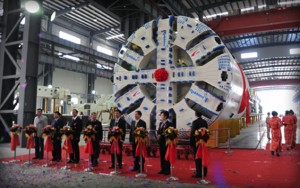 Chengdu’s Metro Line 2 includes 26 stations and 17.6 km (10.9 mi) of tunnels between Longquandong and Shiniu areas of the city. Seven lines totaling 274 km (170 mi) are planned to be operational by 2035, and will service 13.1 million daily passengers.
Chengdu’s Metro Line 2 includes 26 stations and 17.6 km (10.9 mi) of tunnels between Longquandong and Shiniu areas of the city. Seven lines totaling 274 km (170 mi) are planned to be operational by 2035, and will service 13.1 million daily passengers.
The contractor, CRCC Bureau 23, selected a Robbins EPB with a mixed ground cutterhead for the potentially variable conditions, as well as the back-up system, soft ground cutting tools and spares. The machine was launched in January 2010 to bore two 1.4 km (0.9 mi) sections of parallel tunnel, with a breakthrough at the midway point into an intermediate station. The tunnel alignment allowed the machine to pass 25 m (82 ft) below residential buildings, and included several curves with a minimum 400 m (1,300 ft) radius.
Geology
The tunnels for Lot 18 of Line 2 are located in highly variable, permeable alluvium, stiff sand, and clay, requiring a unique EPB TBM design and careful monitoring for settlement. This complex alluvial geology is unlike that found anywhere else in China. Cobbles averaging from 20 to 80 mm (0.8 to 3.1 in) in diameter were predicted, with diameters of as much as 120 mm (4.7 in) possible.
Machine Design
The mixed ground, spoke type cutterhead was mounted with Tungsten carbide knife-edge bits and seven 17-inch (432 mm) diameter disc cutters around the gauge. A foam injection system was used to stabilize the running ground, allowing each cubic meter of foam mixture to stabilize about 40 rings of ground. Subsidence was intensively monitored and crews were trained to utilize probe drilling and ground consolidation if settlement was detected. Variable frequency (VFD) drives allowed the cutterhead rotation to be kept low (around 1.5 RPM at maximum) to also minimize surface settlement. High advance rates were instead achieved using increased cutterhead torque, which results in a faster rate of penetration. One-liquid type back-filling grout was used to fill the gap between segment lining which consisted of 300 mm (12 in) thick reinforced concrete segments set in a 5+1 arrangement.
Tunnel Excavation
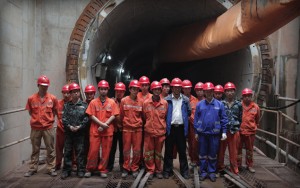 In June 2010, the machine had broken through into the intermediate station, approximately 1,397 m (4,583 ft) into the 2.7 km (1.6 mi) long tunnel. Following scheduled maintenance, the machine was relaunched to bore the remaining section of the tunnel. Cutter wear was very minimal, with only three cutters changed since the start of boring.
In June 2010, the machine had broken through into the intermediate station, approximately 1,397 m (4,583 ft) into the 2.7 km (1.6 mi) long tunnel. Following scheduled maintenance, the machine was relaunched to bore the remaining section of the tunnel. Cutter wear was very minimal, with only three cutters changed since the start of boring.
By the time of tunnel completion in December 2010, the machine had achieved a project landmark of 129 m (423 ft) in one week, and 459.5 m (1,507 ft) in one month – higher rates than at least 4 other machines working on Line 2 in similar geology.
Emisor Oriente
Three Robbins EPBs bore Vital Wastewater Tunnel in Mexico
Project Overview
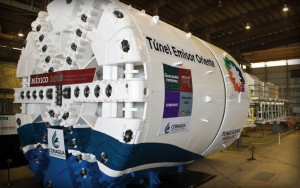 In an urgent effort to prevent flooding in the urban capital of Mexico City, the National Water Commission (CONAGUA) has ordered the construction of a 62 km (39 mi) long wastewater line, Emisor Oriente, which is expected to help increase Mexico City’s wastewater capacity and ease some of the city’s related problems. Torrential rains and continuing floods in Mexico’s capital during the rainy season have increased the urgency of the job, quickly making it the country’s most critical infrastructure project.
In an urgent effort to prevent flooding in the urban capital of Mexico City, the National Water Commission (CONAGUA) has ordered the construction of a 62 km (39 mi) long wastewater line, Emisor Oriente, which is expected to help increase Mexico City’s wastewater capacity and ease some of the city’s related problems. Torrential rains and continuing floods in Mexico’s capital during the rainy season have increased the urgency of the job, quickly making it the country’s most critical infrastructure project.
The Emisor Oriente project was divided into six lots – Lots 1, 2 and 5 awarded to Mexican contractor Ingenieros Civiles Asociados (ICA), S.A. de C.V., Lots 3 and 4 to Carso Infraestructura y Construcción, S.A. de C.V., and Lot 6 to Lombardo Construcciones and Constructora Estrella. Three 8.93 m (29.3 ft) Robbins Earth Pressure Balance Machines (EPBs) are excavating Lots 1, 3, 4, and 5 of the tunnel.
Geology
Mexico City is located in the Valley of Mexico. The area contains an ancient, drained lake bed and is surrounded by volcanic mountain ranges. The soil is mainly made up of watery clays running up to 80 m (263 ft) deep with the water table just 2 to 3 m (6.6 to 9.8 ft) below the surface. The ground also contains boulders up to 600 mm (24 in) in diameter. Due to the complex ground conditions, engineers believed for years that the ground would be too difficult to excavate. Despite the challenging terrain, Mexico City’s main wastewater line, Emisor Central, was hand-mined in 1964 approximately 100 m (328 ft) below ground, paving the path for future underground construction projects.
Equipment Features
The Robbins EPBs were designed for the particularly difficult ground conditions they would be facing on the job site. Although difficult ground was anticipated, shaft excavations in 2009 and 2010 revealed much more complex terrain than originally expected, resulting in various modifications on each machine. The EPBs were built with mixed-ground, back-loading cutterheads with carbide cutter bits to deal with variable ground conditions, and ribbon-type screw conveyors to remove large boulders. Redesigned pressure bulkheads were added to the machines to accommodate the higher water pressures of the region, and enhanced wear detection was added to the cutter bits to ensure optimal performance. Robbins continuous conveyors are being used behind each machine in order to quickly remove muck from the jobsite and minimize downtime. Each continuous conveyor system and vertical belt is installed once the machines have bored ahead 150 m (492 ft) from their launch points.
Excavation
One Robbins EPB was launched for Lot 1 on July 13, 2011 – a change from its originally scheduled tunnel drive at Lot 5. A flood at Lot 1 delayed the Herrenknecht machine that was originally designated to bore the area for six months, prompting the contractor to begin boring with the Robbins EPB. The machine started excavation at shaft 5 of Lot 1 using umbilical cables connected to the surface and a sludge pump for muck removal.
Excavation at Lot 1 was fast-tracked because of problems with Mexico City’s main open sewer line, the Gran Canal. The canal was constructed in 1910 and floods its banks on a regular basis, causing road closures and significant health problems to the city’s residents. The canal has a positive vertical alignment, resulting in potentially large volumes of water that could overload current pumping stations and send untreated water back into the city. The canal’s slope loss is due to the area’s sinking lake clays. To help remedy this problem, a treatment plant and pumping station are being constructed in shaft 5 of Lot 1 so water diverted from the section of the Gran Canal to Emisor Oriente can be pumped back into the Gran Canal where the slope has not been compromised. Although there were many challenges the first EPB machine had faced, it was able to make a successful breakthrough 15 months later. Once the Robbins EPB had bored its 4.6 km (2.9 mi) drive to shaft 3A of Lot 1, it was dismantled, removed, reassembled at Lot 5, and began boring its original 8.6 km (5.3 mi) long bore in early 2014.
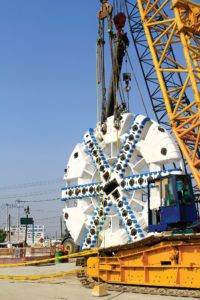 The remaining two Robbins EPBs started excavation in 2012, working on 9.2 km (5.7 mi) and 10.2 km (6.3 mi) drives at Lots 3 and 4, respectively. Once excavation was initiated, the machines quickly encountered sections of abrasive basalt rock and ash, boulders and blocky ground that wore on cutting tools and the cutterhead. As a result, the harsh ground conditions led to accelerated wear and damage on some of the cutting tools as well as the screw conveyors.
The remaining two Robbins EPBs started excavation in 2012, working on 9.2 km (5.7 mi) and 10.2 km (6.3 mi) drives at Lots 3 and 4, respectively. Once excavation was initiated, the machines quickly encountered sections of abrasive basalt rock and ash, boulders and blocky ground that wore on cutting tools and the cutterhead. As a result, the harsh ground conditions led to accelerated wear and damage on some of the cutting tools as well as the screw conveyors.
In efforts to manage the sudden impact of the challenges faced and to maintain control of the situation, the operational parameters at Lots 3 and 4 became a high priority. Improvements to the cutter change time on the central disc cutters were made possible with the design of a new rotary union. To reduce the abrasive wear on the cutterhead, more durable face and gauge scrapers were added to the cutterhead.
The Lot 3 machine underwent additional changes after boring 2.7km (1.6 mi) of its tunnel. The machine was given a new cutterhead fitted with chromium carbide wear plates and smaller openings to reduce blockages. The machine also get a new screw conveyor design with special wear plates, and a reinforced casing with additional gates and injection ports.
At Lot 4, the other Robbins Machine has fared better in soft rock, despite having a lot of water pressure to deal with—the machine even holds the shift record for the project, of 28 rings.
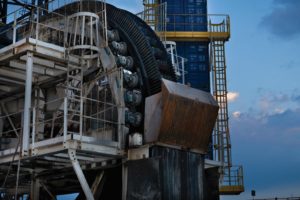 The Lot 5 Robbins machine, which came from Lot 1, needed major modifications before starting at Lot 5 to help deal with expected water pressures up to 7 bar. The TBM—launched from the deepest shaft at a civil works project in Mexico (150 m)—was fitted with new hyperbaric chambers, as well as a new gantry for the compressors and air tanks. To speed up disc changes at the center of the cutterhead, the rotary union was also modified.
The Lot 5 Robbins machine, which came from Lot 1, needed major modifications before starting at Lot 5 to help deal with expected water pressures up to 7 bar. The TBM—launched from the deepest shaft at a civil works project in Mexico (150 m)—was fitted with new hyperbaric chambers, as well as a new gantry for the compressors and air tanks. To speed up disc changes at the center of the cutterhead, the rotary union was also modified.
Project Completion
On May 23, 2019, the last of the six 8.93 m EPBs completed tunneling at Lot 4 of Emisor Oriente, thus ending a ten year campaign of nearly 63 km of tunneling in some of the most arduous conditions crews have ever come across.
With the tunneling complete, the secondary lining operation also had to take place from the various headings using telescopic forms. The tunnel was opened for use in December 2019.
Xi'an Metro Line 1 Lot 12
Robbins EPBs excavate beneath Ancient Chinese City
Project Overview
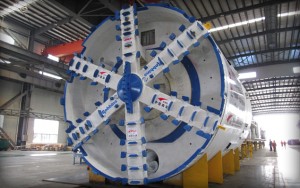 In June and July 2010, commencement of Xi’an’s Metro Line 1 began with the launch of two Robbins machines from Changlepo towards Wanshou Road Station—the first TBMs tunneling on the project.
In June and July 2010, commencement of Xi’an’s Metro Line 1 began with the launch of two Robbins machines from Changlepo towards Wanshou Road Station—the first TBMs tunneling on the project.
Xi’an’s 26.4 km metro Line 1 will run from north to south through the downtown area. Ten TBMs, including two 6.2 m diameter Robbins EPBs, excavated the new rail route. The route travels directly below some of the 3,100 year old city’s most sensitive heritage sites, including the terra cotta warriors.
The Robbins EPBs excavated Lot 12 of Line 1 for the 11th Bureau of China Railway Construction Corporation (CRCC). The parallel 3.6 km tunnels pass through four cut and cover station sites—Changlepo, Wanshou Road, Kangfu Road, and Jinhua Road—under shallow cover ranging from 8 to 22 m. The two TBMs were the first to start excavation on Line 1, and were followed by eight other machines excavating their respective lots.
A total supply contract was signed with China Railway 11th Engineering Bureau Group Limited in June 2009. The second machine assembly was completed in April 2010 at a nearby manufacturing facility in Chengdu before being shipped to the jobsite.
Geology
Both Robbins machines were optimized for geology including sand, abrasive pebbles and clay with significant ground water. Spoke-type cutterheads and 800 mm (32 in) diameter shaft-type screw conveyors aided in efficient advance while maintaining a water-tight seal and balanced pressure.
Tunnel Excavation
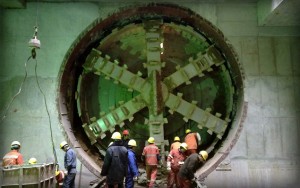 The Lot 12 section was located in a densely urban area, with the tunnels traveling below a college, a hospital, and a marketplace. Crews continuously monitored the excavation rate and overall muck removal volume, by adjusting the thrust force, advance rate, and screw conveyor speed, while keeping the cutterhead speed low, at 1 rotation per minute. Sections of collapsible, water bearing soils were also present in early sections of the tunnel alignment. Crews approached these sections with similar measures, including strict earth pressure control in the mixing chamber, paired with injection of bentonite and water for soil conditioning.
The Lot 12 section was located in a densely urban area, with the tunnels traveling below a college, a hospital, and a marketplace. Crews continuously monitored the excavation rate and overall muck removal volume, by adjusting the thrust force, advance rate, and screw conveyor speed, while keeping the cutterhead speed low, at 1 rotation per minute. Sections of collapsible, water bearing soils were also present in early sections of the tunnel alignment. Crews approached these sections with similar measures, including strict earth pressure control in the mixing chamber, paired with injection of bentonite and water for soil conditioning.
Tunnelling was made even more complex by a city-wide ordinance limiting settlement to ± 15 mm; significantly less than the 25 mm limit that is typical of most Chinese tunnelling projects. The strict settlement guidelines, implemented out of caution due to the ancient structures, required specialized designs for the two Robbins EPBs.
The last intermediate breakthrough, at Jinhua Road station, occurred on July 28, 2011. Advance rates for the Left Line EPB were good—up to 579 m (386 rings) per month and 36 m (24 rings) per day. Planned maintenance was performed while in the cut and cover area, such as changing of cutters and tail seal brushes as well as checkups of the hydraulic system and electrical system. Semi-segment rings consisting of the invert and two segments were installed to allow the machine to ‘walk’ through the 140 m long station site.
Advance rates for the Right Line machine were similarly high—up to 453 m (302 rings) per month and 39 m (26 rings) per day. Settlement was kept below 15 mm with an average settlement of 5 mm.
By summer 2011, one machine had recently completed its second section of tunneling between Wanshou Road and Jinhua Road, and the other was on its last section between Jinhua Road and Kangfu Road in layered loess conditions.
The machines completed tunneling within the project schedule in the last quarter of 2011.
Sochi Complex 3
Robbins TBMs make New Connections for Olympic Games
Project Overview
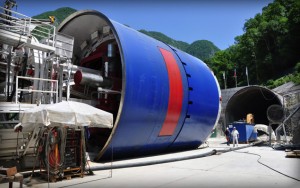 In 2012, the final of two Robbins Double Shield TBMs completed tunneling on schedule in Sochi, Russia in preparation for the host city’s 2014 Winter Olympic Games. In addition to the construction of the new Olympic park, water supply lines, power stations and arenas, the resort city wants to make sure that transportation isn’t a problem for its visitors. The transportation infrastructure project, commissioned by owner DCRC-Sochi, was divided into six complexes and will link road and railway routes between the small town of Adler on the Black Sea and the mountain resort of Alpika. The new lines will also connect to the M-27 highway, which travels along the Mzymta River through a national forest preserve with 46 bridges and 12 tunnels.
In 2012, the final of two Robbins Double Shield TBMs completed tunneling on schedule in Sochi, Russia in preparation for the host city’s 2014 Winter Olympic Games. In addition to the construction of the new Olympic park, water supply lines, power stations and arenas, the resort city wants to make sure that transportation isn’t a problem for its visitors. The transportation infrastructure project, commissioned by owner DCRC-Sochi, was divided into six complexes and will link road and railway routes between the small town of Adler on the Black Sea and the mountain resort of Alpika. The new lines will also connect to the M-27 highway, which travels along the Mzymta River through a national forest preserve with 46 bridges and 12 tunnels.
The entire project consists of 48.2 km (30 mi) of new road and railway lines, with a strict completion deadline of June 2013. In order to meet the schedule, excavation was performed in various ways, including using roadheaders, drill and blast equipment, and five TBMs.
Custom Rebuilds
Contractors OJSC Stroy-Trest and CSC Bamtunnelstroy ordered two refurbished TBMs to excavate parallel service and railway tunnels measuring 5.8 km (2.8 mi) and 4.6 km (2.9 mi), respectively. The rebuilt machines were selected to construct the tunnels due to their fast procurement time compared to new machines and the aggressive deadline of the project. A 10.0 m (32.8 ft) TBM was originally used on the Abdalajis rail tunnels in Spain between 2003 and 2006 and removed from storage for the Complex 3 tunnel. A 6.2 m (23.3 ft) Double Shield was originally built in 1993 for a hydroelectric project in Switzerland, and has since been used on multiple tunneling projects, totaling over 45 km (28 mi).
The 10.0 m (32.8 ft) machine was supplied for the Sochi project as rebuilt by a sub-contracted supplier, but several problems at start-up unveiled that some of the machine’s major components needed to be refurbished or replaced. After learning this, Bamtunnelstroy hired Robbins for on-site technical service and project consulting for Complex 3, as they were the original manufacturers of two of the three TBMs.
A crew of 15 from Robbins field service and engineering departments repaired and modified both TBMs. The 10.0 m (32.8 ft) machine received a new cutterhead support from Italy, while the main bearing was refurbished at a factory in Germany. In order to transport the 30 metric ton main bearing, the Antonov 124-100 aircraft was used, as it is the only one in existence that can carry these loads. The TBM also received upgrades to the lube system, cutterhead pressurization, and changes to the seal lubrication system. The 6.2 m (23.3 ft) Double Shield received new gear boxes and a PLC system. To make sure boring went smoothly, the Robbins crew stayed onsite until both machines were up and running.
Geology
The Robbins TBMs were specifically designed to excavate the fractured and faulted sedimentary geology that makes up the Sochi region. After testing the soil, it was determined that the machines would be boring mostly massive to completely fractured limestone with clay seams. Some sedimentary rock with sandstone and siltstone was also detected, as were fault zones made up of breccias and conglomerates.
Both machines were designed with a flat face, low profile muck buckets and radial scoops to optimize stabilization at the face of the tunnel. They were also equipped with replaceable bucket lips and injection ports, which allow foam additives to be injected into the soil through the cutterhead to treat the ground before and during boring.
Tunnel Excavation
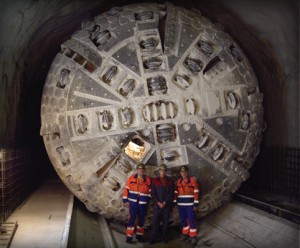 The 6.2 m (23.3 ft) TBM was launched in March 2010 in mixed ground. In May, however, the machine was stopped after it came across a fault zone consisting of broken rock and running soft ground. Field service crews were able to free the machine by hand excavating a timber bypass structure around the machine in front of the cutterhead, allowing debris to be removed. To evaluate the ground ahead, the crew drilled up to 62 m (203.4 ft) in front of the machine and found that the geology consisted of highly fractured ground. In order to accommodate the ground, polymer foam was injected in front of the machine to consolidate porphyry material around and in front of the cutterhead. The TBM was able to move forward without a problem once this was completed. To prevent a recurrence of the problem, crews performed continuous probe drilling during the remainder of the advance. When necessary, the ground was treated with cement silicate and foam to keep the machine moving steadily forward.
The 6.2 m (23.3 ft) TBM was launched in March 2010 in mixed ground. In May, however, the machine was stopped after it came across a fault zone consisting of broken rock and running soft ground. Field service crews were able to free the machine by hand excavating a timber bypass structure around the machine in front of the cutterhead, allowing debris to be removed. To evaluate the ground ahead, the crew drilled up to 62 m (203.4 ft) in front of the machine and found that the geology consisted of highly fractured ground. In order to accommodate the ground, polymer foam was injected in front of the machine to consolidate porphyry material around and in front of the cutterhead. The TBM was able to move forward without a problem once this was completed. To prevent a recurrence of the problem, crews performed continuous probe drilling during the remainder of the advance. When necessary, the ground was treated with cement silicate and foam to keep the machine moving steadily forward.
Despite its challenges, the 6.2 m (23.3 ft) TBM experienced good advance rates of 100 to 120 m (328.1 ft to 393.7 ft) per week, and 14 m (46 ft) per day. The machine achieved breakthrough at the service tunnel on March 2, 2011. After completion, the machine was disassembled and is now being stored near the city of Novorossiysk. It is expected to be used for future tunneling projects, as it is in good shape and experienced very low cutter wear during its bore on Complex 3.
The 10.0 m (32.8 ft) Double Shield was launched in September 2010 and excavated effectively through fault zones 25 and 50 m (82.0 and 164.0 ft) wide, consisting of highly weathered material have been excavated so far, using probe drilling and pre-grouting to consolidate the rock. The massive machine completed its excavation in 2012, breaking through on February 14.
Zhengzhou Metro Line 1
Project Overview
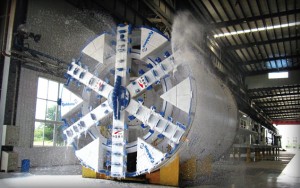 The Zhengzhou Metro consists of twin underground tunnels as part of a larger project for the 11th Bureau of the China Railway Construction Corp. (CRCC) to create the first metro system in the city. Approximately seven million people live in Zhengzhou so the new metro lines will help relieve congestion and allow Zhengzhou to become a center for rail commerce in China.
The Zhengzhou Metro consists of twin underground tunnels as part of a larger project for the 11th Bureau of the China Railway Construction Corp. (CRCC) to create the first metro system in the city. Approximately seven million people live in Zhengzhou so the new metro lines will help relieve congestion and allow Zhengzhou to become a center for rail commerce in China.
The future construction of up to four metro lines is planned for the area, with freight lines between Beijing and Guangzhou (North-South), and Xuzhou and Lanzhou (East-West) intersecting the city. Once complete in 2013, Line 1 of the metro will be 26 km (16 mi) long and include 22 stations. The Zhengzhou Metro Company has invested Yuan 10.2 billion (USD 1.5 billion/EUR 1.1 billion) in the new metro project. Once all lines have been completed – sometime between 2015 and 2030 – the entire metro line will stretch 188 km (117 mi).
Geology
Soft, powdery soils made up the first part of the drive. Line 1 involved excavation under urban areas of Zhengzhou with cover as low as 7 m (23 ft) for almost half the length of the tunnel. The drive also included a section of tunnel just 7.0 m (23 ft) below Xi Liu Lake, with depths of 1.0 to 2.0 m (3.2 to 6.6 ft). The terrain in this section consisted of permeable soil with underground water below the lake fed by vertical leakage, resulting in challenging ground conditions.
Equipment Features
The Robbins EPBs were designed using spoke-type, soft ground cutterheads with tungsten carbide knife-edge bits. The electric, variable speed drives power the cutterheads at 750 kW (1,005 HP), allowing them to rotate at a speed of 0.3 to 2.0 revolutions per minute. To remove liquidized muck, the EPBs are equipped with shaft-type screw conveyors 800 mm (31 in) in diameter, which take the muck to muck cars for extraction from the tunnel. The thrust rate of both EPBs is 36,000kN (8.1 million lb), with a maximum torque of 4,785 kNm (3.5 million lb-ft) and a maximum stroke of 1,950 mm (77 in).
Both machines were designed with active articulation, which allowed them to bore curves on small radii while keeping the segment lining of the tunnel intact. The segment lining was made of reinforced concrete, 300 mm (12 in) thick, in a 5+1 arrangement with each segment 1.5 m in length. To help stabilize the tunnel lining, one-liquid type backfill was injected between the segment lining and the soft ground to fill in temporary gaps and help minimize subsidence.
TBM Excavation
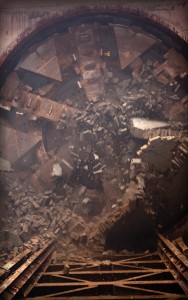 Each tunnel is 3.6 km (2.2 mi) long, passing through four intermediate stations between Kaixuan and Tongbo areas. The machines used on this project were manufactured at Chengdu CSR Tunnelling Equipment Co., Ltd. and launched in November and December 2010. Structural challenges in the low cover tunnel included a highway interchange bridge and building foundations nearby. Foam and bentonite were injected into the soil to improve its condition and reduce settlement. Following the successful completion of these sections, the machines achieved two intermediate breakthroughs into cut and cover sites in early 2011.
Each tunnel is 3.6 km (2.2 mi) long, passing through four intermediate stations between Kaixuan and Tongbo areas. The machines used on this project were manufactured at Chengdu CSR Tunnelling Equipment Co., Ltd. and launched in November and December 2010. Structural challenges in the low cover tunnel included a highway interchange bridge and building foundations nearby. Foam and bentonite were injected into the soil to improve its condition and reduce settlement. Following the successful completion of these sections, the machines achieved two intermediate breakthroughs into cut and cover sites in early 2011.
Line 1 of the Zhengzhou Metro was completed in October and November 2011, at least two weeks ahead of schedule. The two 6.3 m (20.7 ft) Robbins Earth Pressure Balance Machines (EPBs) have set a Chinese EPB record in their size class, excavating up to 720 m (2,362 ft) in one month. Daily advance rates of the machines reached 22 rings (33 m/108 ft) in two 10-hour work shifts. These rates additionally mark a project record compared to nine other machines that worked on the job
Tahoe Forest Hospital District Central Energy Plant Prep Project
Project Overview
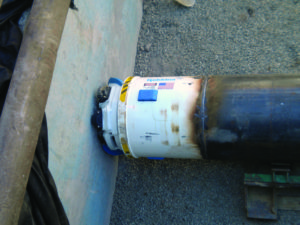 The Tahoe Forest Hospital is an expanding healthcare center located in Truckee, California. In autumn 2010, they were in the process of designing a new cancer wing when it was determined that additional utility and mechanical lines were required before the new building could be built. To house the bundled utilities, three crossings needed to be bored directly below the active main hospital.
The Tahoe Forest Hospital is an expanding healthcare center located in Truckee, California. In autumn 2010, they were in the process of designing a new cancer wing when it was determined that additional utility and mechanical lines were required before the new building could be built. To house the bundled utilities, three crossings needed to be bored directly below the active main hospital.
General contractor AM-X Construction & Excavation, Inc. subcontracted the three parallel 21 m (70 ft) sections to Silver State Boring Inc. Due to variable ground conditions and hospital noise constraints, the contractor opted for a Robbins SBU-A with a mixed ground head. This was the first time Silver State had used this type of cutterhead, but they were confident that it was the right machine for the job.
Geology
The hospital is set on ground containing large granite boulders, and Silver State was worried that one of these rocks would be hit during boring. This concern was actualized 7.6 m (25 ft) into the first bore when the SBU-A caught the edge of a boulder about 3.7 m (12 ft) in diameter. During the second bore, the machine drilled straight through the same boulder. Additional boulders of 175 MPa (25,000 psi) UCS were encountered during the third bore, and the SBU-A successfully powered through them as well.
What is a Mixed Ground SBU-A?
The Robbins SBU-A is a circular cutting head mounted with a combination of tungsten carbide bits, single disc cutters, and multi-row disc cutters. The SBU-A is available in diameters from 600 mm to 1.8 m (24 to 72 in), and can excavate a wide variety of hard rock and mixed ground conditions including dry soils, clay, cobbles and boulders from 25 to 175 MPa (4,000 to 25,000 psi) UCS.
During boring, the SBU-A is welded to an Auger Boring Machine (ABM), which provides both torque and thrust to the cutting head. Drag bits scrape soil from the machine face, while disc cutters excavate sections of rock. Muck scrapers scoop the excavated rock into large openings in the cutterhead, allowing for a smooth flow of muck from the face to the auger string.
Excavation
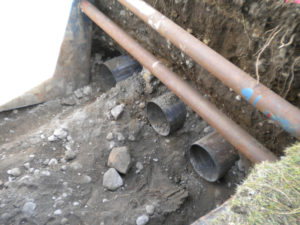 The SBU-A bored 2 m (8 ft) below the hospital’s foundation for the three jack-and-bore crossings. Straight bores were needed due to tight exit space, and each one began with a 609 mm (24 in) thick concrete starting block to keep the machine properly aligned. In addition, the older hospital has many buried utilities that needed to be cut and bypassed during site excavation. To make sure that everything would run smoothly, Robbins field service technicians visited the site prior to launch to assist with setup and crew training.
The SBU-A bored 2 m (8 ft) below the hospital’s foundation for the three jack-and-bore crossings. Straight bores were needed due to tight exit space, and each one began with a 609 mm (24 in) thick concrete starting block to keep the machine properly aligned. In addition, the older hospital has many buried utilities that needed to be cut and bypassed during site excavation. To make sure that everything would run smoothly, Robbins field service technicians visited the site prior to launch to assist with setup and crew training.
The first of the three bores began in October 2010, and by November 2010 all three bores were successfully completed. Advance rates for the duration of the project were approximately 3 m (10 ft) per day.
Due to the low torque and impact of the SBU-A, little stress was put on the ABM, no cutter changes were needed between bores, and the hospital was unaffected by noise or vibration during boring. Silver State was very pleased with the results, and used the technology again in 2011 for 609 mm (24 in) diameter bore in South Lake Tahoe, Nevada.
City of Clinton Contract B Force Main Project
Project Overview
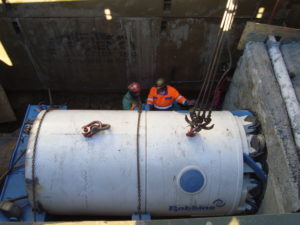 The Iowan towns of Clinton, Camanche and Low Moor have been identified as communities in desperate need of updated wastewater treatment systems. The towns all have over 10,000 residents, but their water and sewer treatment plants are inadequate and often over capacity. In 2009, a statewide recovery program called I-JOBS was created in Iowa, and USD $20 million in project funding was allocated to improving water quality. These funds were set aside for water treatment projects in the three towns.
The Iowan towns of Clinton, Camanche and Low Moor have been identified as communities in desperate need of updated wastewater treatment systems. The towns all have over 10,000 residents, but their water and sewer treatment plants are inadequate and often over capacity. In 2009, a statewide recovery program called I-JOBS was created in Iowa, and USD $20 million in project funding was allocated to improving water quality. These funds were set aside for water treatment projects in the three towns.
The City of Clinton awarded their portion of the funding, USD $9.5 million, to general contractor Merryman Excavation. Illinois-based L.J. Keefe Co. was chosen as the sub-contractor for the project. The contract, known as City of Clinton Contract B Force Main, called for six crossings below roadways and rivers, three of which required TBM tunneling. The remaining three crossings required SBUs. Two Robbins SBU-As were chosen for the 26.2 m (250 ft) and 82.3 m (270 ft) runs, and a third Robbins motorized SBU (SBU-M) was selected for the 120.4 m (395 ft) crossing.
Geology
The 26.2 m (250 ft) and 82.3 m (270 ft) crossings undercut the Mississippi river, and were identified as hard rock bores of over 70 MPa (10,000 psi) UCS in which SBU-As would be the best choice. The longest crossing was below traffic-heavy Highway 67, and testing of the area revealed a mixed face of sand, clay and 70 MPa (10,000 psi) UCS hard rock. Due to the variable ground conditions, the contractor opted for a 1.8 m (72 in) SBU-M, the largest of its kind yet built.
About the SBU-A
The Small Boring Unit (SBU-A) is a hard rock and mixed ground circular cutterhead which utilizes an Auger Boring Machine (ABM) and steel casing. During excavation, the SBU-A is welded to the lead casing while the ABM provides torque and forward thrust to the cutterhead.
The SBU-A is available in diameters ranging from 600 mm to 1.8 m (24 to 72 in), and its single disc cutters are capable of excavating rock from 25 to over 175 MPa (4,000 to over 25,000 psi) UCS. The cutters penetrate the rock face, creating a “crush zone” through which fractures occur. Material between adjacent crush zones falls from the face into muck buckets in the cutterhead. A full face auger is used to transfer the muck for removal.
About the SBU-M
The SBU-A’s cousin, the SBU-M, is a motorized SBU used for longer bores and line-and-grade critical crossings. In similar fashion to the SBU-A, the SBU-M is welded or bolted to the lead casing of an ABM. The machine is continuously steered by way of an operator’s console in the rear shield. A laser targeting system is used to monitor the machine’s heading. These features allow for increased accuracy and continuous monitoring, which was needed on the 120.4 m (395 ft) bore due to the mixed ground geology, strict line-and-grade requirements, and crossing length.
Excavation
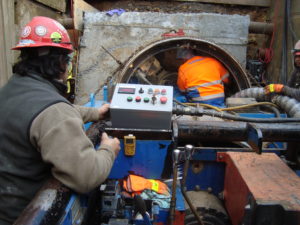 In November and December 2011, the 1.5 m (60 in) and 1.06 m (42 in) SBU-As, respectively, were launched 9.1 m to 10.6 m (30 to 35 ft) beneath a tributary of the Mississippi River. Each utilized an 18.3 m (60 in) ABM to excavate in the hard rock conditions. Both SBU-As broke through on time and within line-and-grade specifications. The first SBU reached completion on December 20, 2011, and its counterpart did the same on February 10, 2012. Each averaged advance rates of 6.1 m (20 ft) per day.
In November and December 2011, the 1.5 m (60 in) and 1.06 m (42 in) SBU-As, respectively, were launched 9.1 m to 10.6 m (30 to 35 ft) beneath a tributary of the Mississippi River. Each utilized an 18.3 m (60 in) ABM to excavate in the hard rock conditions. Both SBU-As broke through on time and within line-and-grade specifications. The first SBU reached completion on December 20, 2011, and its counterpart did the same on February 10, 2012. Each averaged advance rates of 6.1 m (20 ft) per day.
The 1.8 m (72 in) SBU-M was launched in January 2012 from a 7.6 m (25 ft) launch pit. Although the machine encountered an unexpectedly long drive of hard clay just 4.6 m (15 ft) into its bore, crews were able to keep moving by adding water through the cutterhead and the casing. This kept the muck coming through without contaminating the disc cutters.
Although challenging, advance rates of 6.2 m (20 ft) per day were maintained in the softer ground conditions. After about 70.1 m (230 ft) worth of clay, the machine hit solid rock for the remainder of the run. While in hard rock, rates increased to about 90.1 m (30 ft) per day.
On February 14, 2012, the SBU-M broke through into a receiving pit. It finished within line-and-grade requirements with very little deviation, even in the mixed face ground conditions during initial boring.
Recent Posts
- Twin Robbins EPBs make milestones near Taj Mahal
- Long Haul TBM: Use of a Rebuilt Main Beam Machine at the DigIndy Tunnel System in Indianapolis, IN
- Evaluating TBM Design and Performance, 30 Years Apart: The Lesotho Highlands Water Tunnel, Phase 1 and Phase 2
- Overcoming Mountainous Geology at Nepal's Sunkoshi Marin Project
- Swift Robbins TBM breaks through 11 Months Early

 Close
Close  Menu
Menu 
